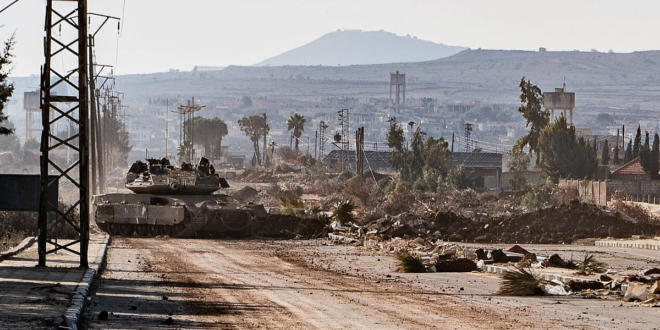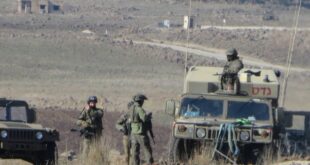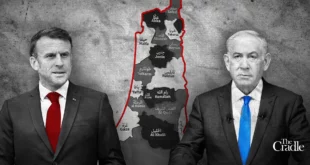Israeli forces have advanced miles into Syrian territory — confiscating land and homes, killing farmers, and seeking to divide the region’s diverse population.
As it resumes military operations in the Gaza Strip, Israel has expanded its ground incursions across southern Syria in recent weeks, while also launching airstrikes throughout the country — from Latakia and Homs to rural Damascus. In a major attack on March 25, Israeli forces shelled Koya, a small village in the Yarmouk Valley in Deraa Governorate, leaving at least six dead.
“[Israeli troops] started shooting at the farmers as soon as they saw them,” Nadia Aboud, a 28-year-old journalist from the nearby city of Deraa, told +972, recounting testimonies from village residents. “The farmers, who keep weapons to protect their land, fired back.” The situation quickly spiraled into a larger clash, with the Israeli military launching at least one airstrike on the village. “Two of [the farmers] were killed on the spot. When others rushed to help, the fighting intensified.”
Though Aboud stressed that “the people of Deraa want peace and for the [1974 Syrian-Israeli disengagement agreement] to be upheld,” she warned that resistance would persist. “If Koya is attacked again, they’ll defend it to the last man.”
The attack on Koya was among the deadliest since Israel invaded Syria some four months ago. On Dec. 8, just hours after the collapse of former Syrian President Bashar Al-Assad’s regime, Israeli forces moved swiftly to seize abandoned mountaintop checkpoints, occupying territory in violation of the 1974 agreement.
Since then, Israeli warplanes have conducted near-daily flights and struck Assad’s former military sites — 600 attacks in the first eight days of military operations. Meanwhile, ground troops have advanced 12 miles into Syrian territory, building at least nine military bases and expanding road networks and other communications infrastructure.
The Israeli high command justifies its bombardments as necessary to prevent the weapons stockpiles from falling into the hands of Damascus’ new government, led by interim president Ahmed al-Sharaa. Yet al-Sharaa has shown no signs of seeking conflict with Israel, focusing his attention on rebuilding Syria and lobbying to lift international sanctions, while Iran’s influence in Syria has been systematically weakened by Assad’s departure. And on the ground, often in the vicinity of former military outposts, a scattering of villages remains — home to thousands of Syrians who bear the brunt of Israel’s new, violent military occupation.
Divide and conquer
In Rasm al-Rawadi, a small village near Quneitra in the demilitarized Syrian-Israeli buffer zone, residents awoke on Dec. 8 to the sound of gunfire and aerial bombardment. “At 11 a.m., [Israeli] soldiers broke down the doors of the houses to check everything inside,” Ali al-Ahmad, a 65-year-old village elder, recounted. “While the Israeli army searched the houses and destroyed some of them, many families were placed in a school.” For the past four months, the village has remained under Israeli control and almost 350 people have been forced out of their homes — taken over, according to al-Ahmad, for military use.
Although Prime Minister Benjamin Netanyahu initially framed the Israeli incursion into southern Syria as “temporary,” Israel’s deepening military presence suggests otherwise. More recently, Defense Minister Israel Katz affirmed that Israel is prepared to stay in the country indefinitely.
Mohammed Fayyad, a lawyer and human rights activist, was beaten and detained by Israeli forces in January while covering their operations in the village of Hamidye. In addition to these violent encounters, he told +972 in his office in Quneitra that Israeli military officials have been “entering villages in white civilian vehicles to collect data, carrying out statistical questionnaires under the pretext of offering humanitarian aid.” In addition, he claimed that they have been offering to pay locals “at least $75 per day to build the bases’ infrastructure.
“After taking everything from us, they offer us food, medicine, electricity, and work,” Fayyad explained. “They aim to provoke division and separation from the new administration.” But so far, he noted, residents have been rejecting these offers and “refuse any interference regarding the division of Syria.”
On Feb. 24, families in Quneitra and Deraa experienced a night of Israeli shelling after a month of relative calm. The next day, they woke up to tanks and armed pickup trucks rolling into their villages. The assault came just after Syria’s first National Dialogue Conference, where political and religious leaders from all communities had gathered to discuss the country’s future.
“We have just finished a war, but we have no problem starting another one with Israel to defend our country,” 47-year-old Omar Hanoun told +972 in his home in the village of Al-Rafeed, near Quneitra. Hanoun was one of the organizers of a civilian protest on Feb. 25 against Israel’s military incursion as soldiers advanced on the village from Mount Peres, which has remained under Israeli control since the occupation of the Golan in the 1967 war.
According to Hanoun and other locals +972 interviewed, the conduct of the invading Israeli soldiers has followed a similar pattern across many villages in the region. “They destroyed 100-year-old trees and shot at anyone who came near,” he said, describing the Israel army’s arrival in Al Asbah, a small village near Al-Rafeed. “They even killed two young men on a motorbike who carried a shotgun with them, which is normal in this region to protect livestock.”
Bader Safi, a teacher at the local school in Kodana, a village on the border of the occupied Golan, told +972 that dozens of Israeli soldiers have confiscated residents’ land and conducted regular patrols through the town with dogs. “I have lost count of how many times they have entered our village,” he said. “A neighbor and friend of mine whose land was taken [by the soldiers] is living in my house. He cries every day because he has lost everything.”
Sheikh Abu Nasr, 70, from Al-Rafeed, said that when the Israeli army invaded, the local population resisted orders to remain inside their homes. “We believe this is our land. We planted grapes and figs here. We don’t recognize the occupying state,” he said, adding that the new Syrian government’s forces never came to the village to offer assistance. “We are alone, but we will stay here on our land, even if someone else controls us.”
Sheikh Abu Nasr at the gate of his house in Al-Rafeed village near Quneitra, Syria, Feb. 20, 2025. (Tareq al-Salameh)
Exploiting the Druze
Another tactic Israel has been using to justify its occupation is to claim the support of southern Syria’s Druze, the third largest religious minority at around 3 percent of the country’s population. Drawing on the loyalty of Israeli Druze, who serve in its armed forces in significant numbers, Israel has sought to portray its presence as locally sanctioned.
On March 1, Netanyahu and Katz ordered Israeli army forces to prepare to defend Jaramana, a Druze village in southern Syria. “We will not allow the extremist Islamic regime in Syria to harm the Druze,“ Katz declared, following reports of clashes in the Damascus suburb. “If the regime attacks the Druze in Jaramana, we will respond.”
Once a small neighborhood on the outskirts of Damascus, Jaramana is today home to more than a million working-class Syrians. According to resident K. Aboulhosn, a 25-year-old arts student, Jaramna is now a “multi-ethnic and multi-religious city,” whose population swelled during the civil war when it became a “refuge for displaced people from other areas of Damascus because of its relative calm.”
Externally, the two skirmishes in Jaramana that sparked the Israeli reaction — one at Al-Mujtahed hospital and another at Jaramana checkpoint — appeared to be a dispute between local security personnel and the forces of the new Syrian government led by Ahmad al-Shara. But according to Makram Oubaid, a lawyer with the Jaramana Civil Action Committee, they were in fact “two unrelated clashes of a personal nature” that escalated into a larger-scale confrontation. The incidents ultimately led to an agreement allowing Hayat Tahrir al-Sham (HTS) forces, who, according to Oubaid, “only intervened to stop the fighting and restore order,” to establish an office and share security responsibilities in the village with the local Druze population.
Regardless of the nature of the clashes, for the Israeli government, the situation presented an opportunity to exploit the Druze population to further assert its influence over Syria. A week before the incident in Jaramana, Netanyahu had announced that Israel would not tolerate “any threat against the Druze community in southern Syria.”
Now, as Syria’s diverse religious and ethnic groups negotiate their fragile coexistence after Assad’s fall, Israel’s invasion threatens to shatter this delicate balance. “Israel’s intervention is widening the divide between Druze and other Syrian communities,” Farid Ayach, a 32-year-old professor of visual arts, told +972 from his flat in Jaramana. “It is also generating unrest in neighboring countries, which favors Israel’s interests [as well].”
So far, all indications are that the Israeli army will not withdraw from the areas it occupied in southern Syria. Indeed, most signs point to further escalation, as Israel continues to entrench its positions and take further land. However, following the February attacks in Quneitra and Deraa, the local population has become increasingly involved in resisting the Israeli offensive.
Demonstrations against the invasion have taken place in various parts of Damascus, as well as in Deraa, Khan Arnabeh, Suwayda, and multiple towns and villages in Quneitra. Even the Druze community has rejected offers of humanitarian aid and mobilized in defiance. When Defense Minister Katz pledged to “assist” Jaramana’s Druze, Suwayda’s Druze militias mobilized toward Damascus, determined to defend their people from Israel’s supposed rescue mission.
 Eurasia Press & News
Eurasia Press & News



